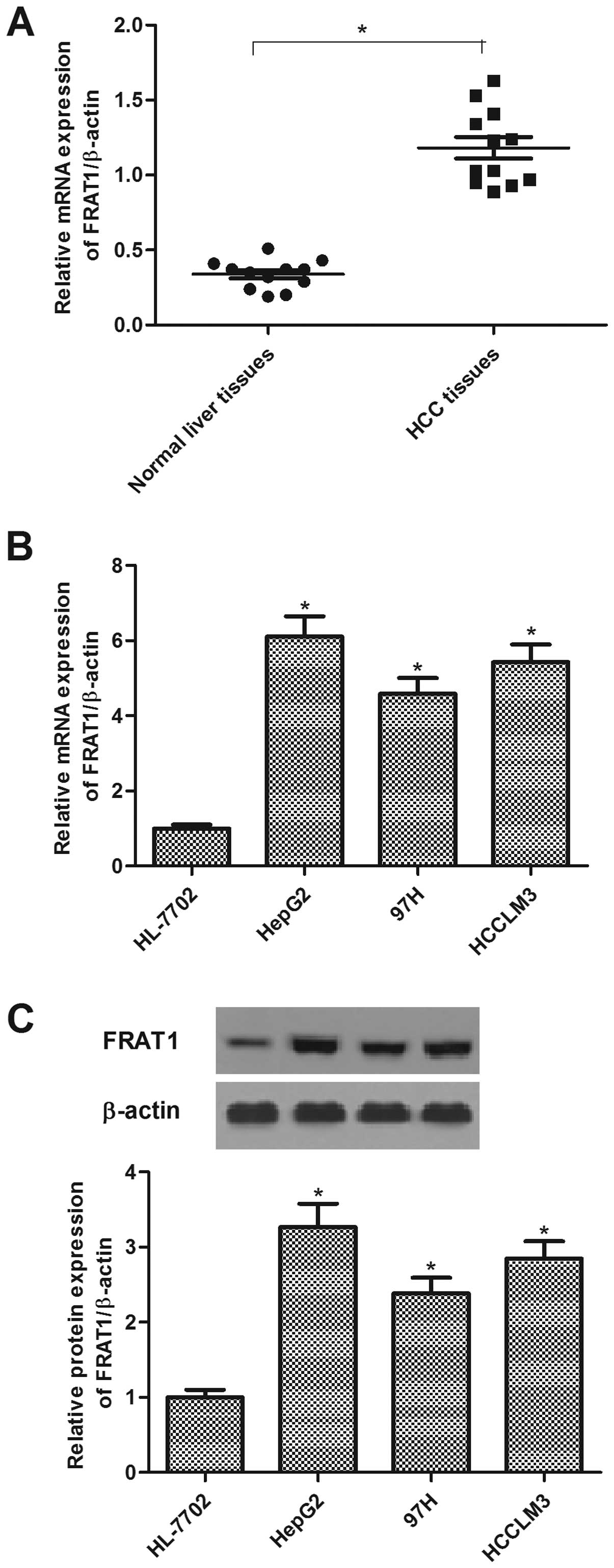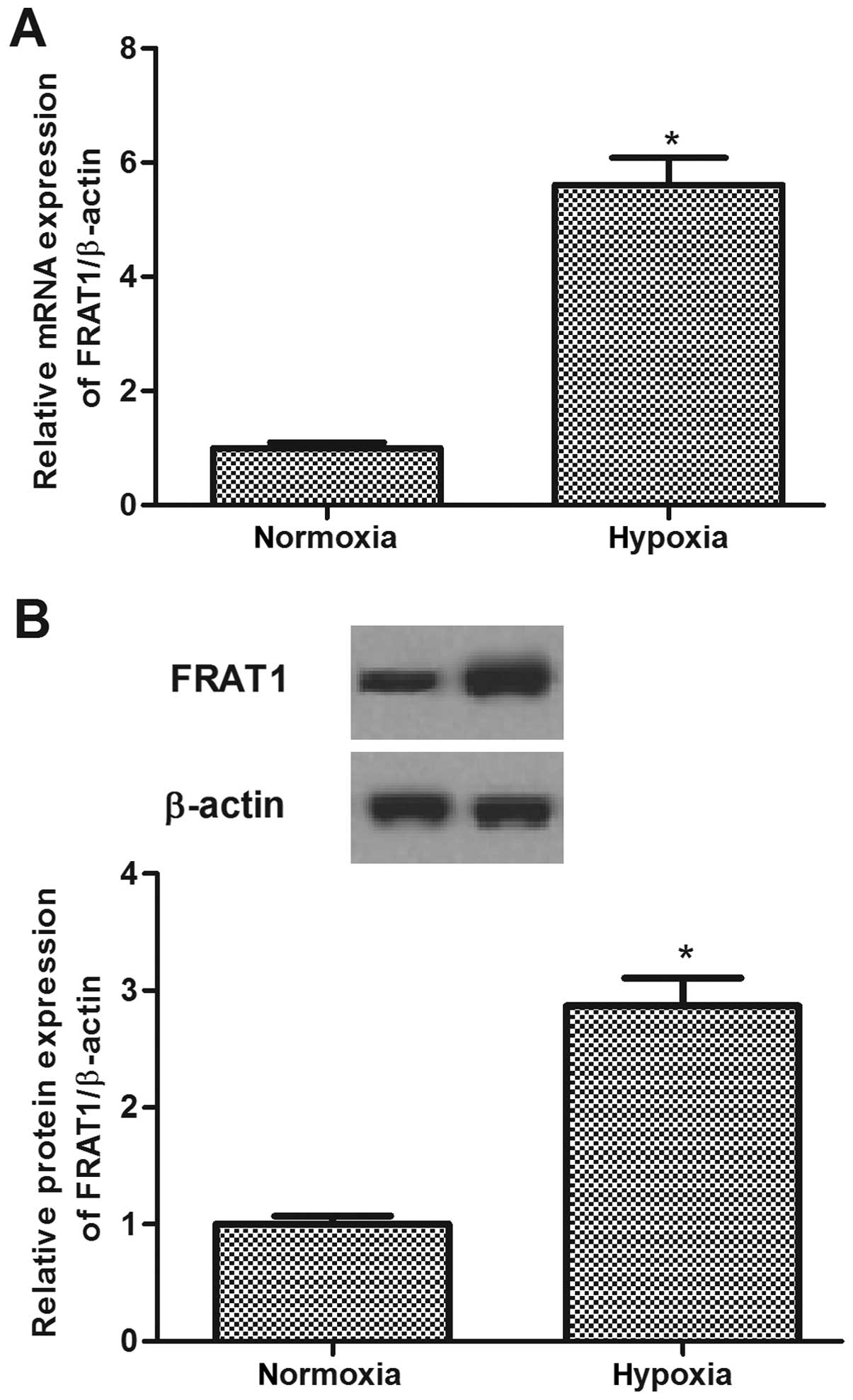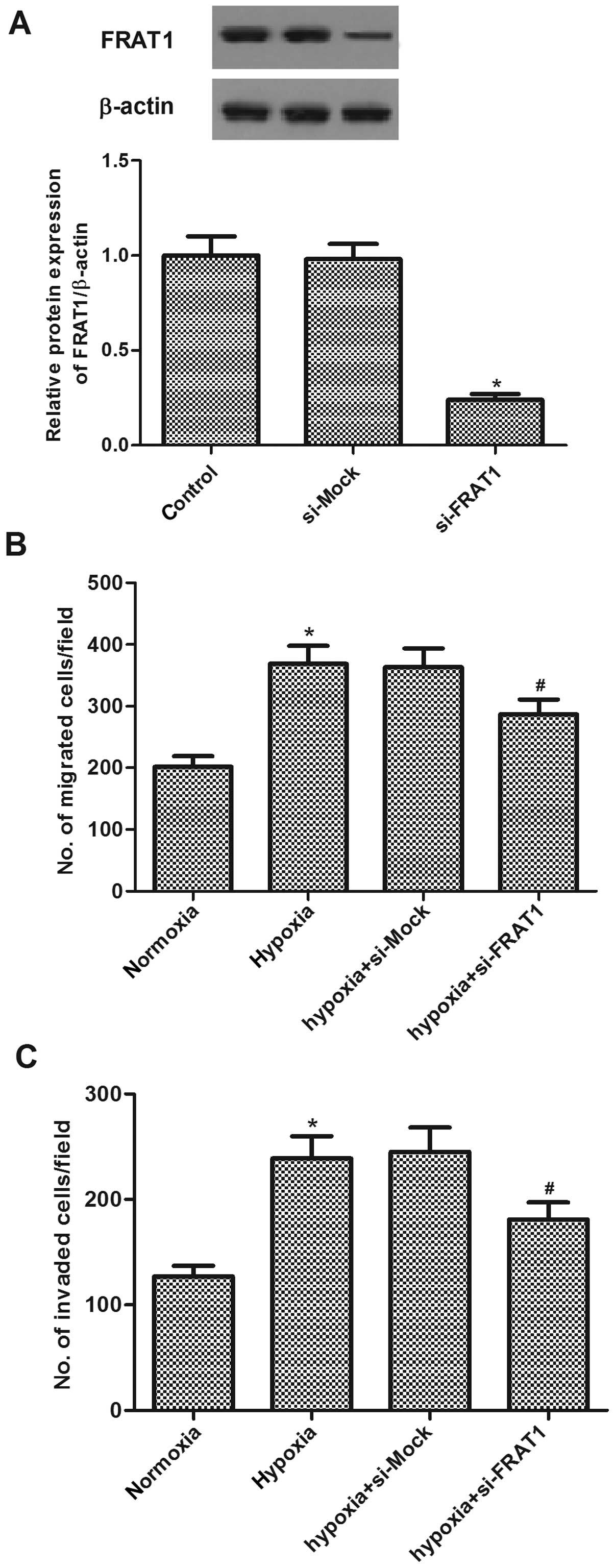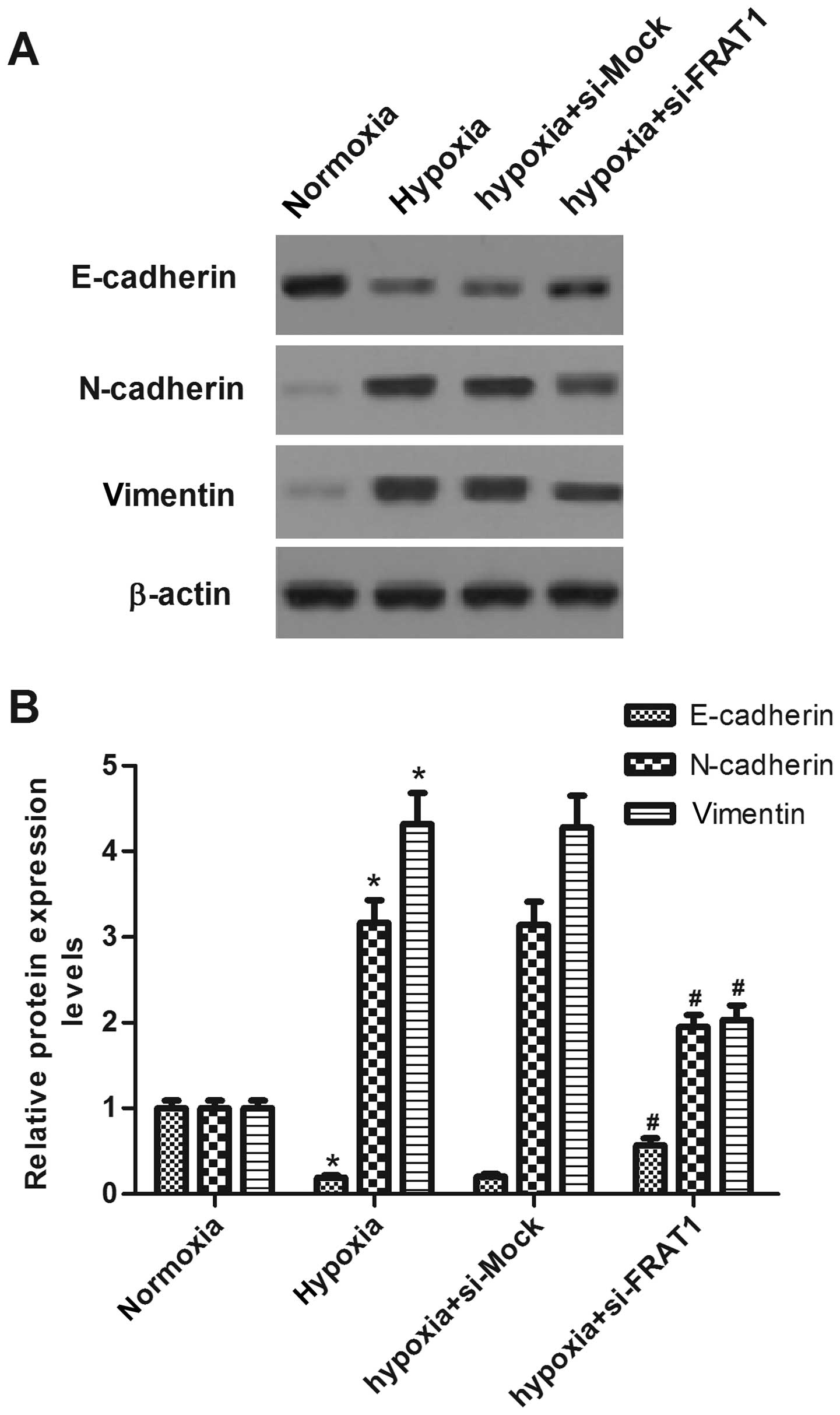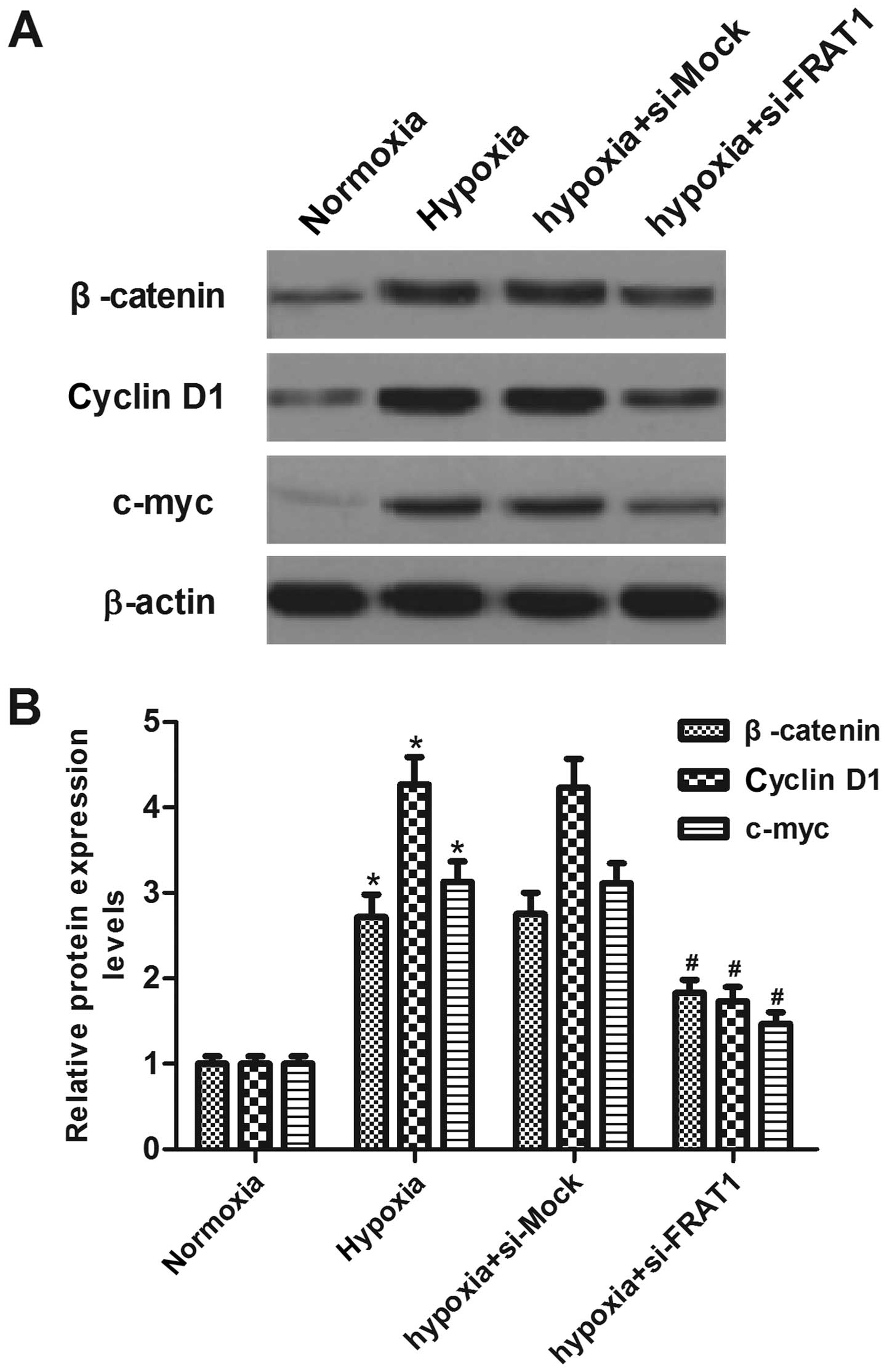Knockdown of FRAT1 inhibits hypoxia-induced epithelial-to-mesenchymal transition via suppression of the Wnt/β-catenin pathway in hepatocellular carcinoma cells
- Authors:
- Published online on: September 23, 2016 https://doi.org/10.3892/or.2016.5130
- Pages: 2999-3004
Abstract
Introduction
Hepatocellular carcinoma (HCC) is one of the most common malignancies in the world (1). Although the surgical approaches and adjuvant chemotherapy have improved, the survival rate of HCC patients at advanced stages remains low (2–4). Therefore, it is imperative to investigate the molecular mechanisms of HCC to provide novel therapeutic approaches.
Epithelial-mesenchymal transition (EMT) is a crucial step in tumor progression. During EMT, epithelial cells lose their characteristic marker E-cadherin and gain mesenchymal markers including N-cadherin and vimentin (5,6). Hypoxia is an essential component of the neoplastic microenvironment. It contributes to the progression of various cancers by activating adaptive transcriptional programs that promote cell survival, motility, and tumor angiogenesis. In HCC, regions of hypoxia are present throughout the tissue because of areas of necrosis and irregular blood flow (7). Previous studies showed that hypoxia induces EMT in HCC cells (8,9). Under hypoxic conditions, cancer cells develop escape mechanisms to survive and leave the unfavorable environment (10). Afterwards, they acquire increased potential for local invasion and ability to evade to distant organs. Thus, preventing hypoxia-induced EMT is a promising approach for treatment of HCC.
The frequently rearranged in advanced T-cell lymphomas-1 (FRAT1) gene, located on human chromosome 10q24.1, encodes a 29-kDa protein comprising 279 amino acids (11). It is a positive regulator of β-catenin in the Wnt pathway (12). Previous studies have shown that FRAT1 plays a critical role in different types of tumors (13–15). For example, Guo et al reported that silencing of FRAT1 inhibits human glioblastoma cell growth, migration and invasion (16). However, the expression and role of FRAT1 in HCC has not been elucidated. In this study, we investigated the effect of FRAT1 on EMT process in HCC cells induced by hypoxia.
Materials and methods
Tissue specimens
A total of 12 HCC and 12 non-cancerous liver tissue samples were obtained from the Department of Infectious Disease, The First Affiliated Hospital of Xi'an Jiaotong University (China), during the period from 2014 to 2015. Dissected samples were frozen immediately after surgery and stored at −80°C until needed. A protocol for the use of patient samples was approved by the Medical Ethics Committee of the First Affiliated Hospital of Xi'an Jiaotong University (China) and written informed consent was obtained from each patient.
Cell culture and hypoxia treatment
Three human HCC lines (HepG2, 97H and HCCLM3) a hepatocyte cell line (HL-7702) were purchased from the American Type Culture Collection (ATCC, Manassas, VA, USA). These cells were cultured in Dulbecco's modified Eagle's medium (DMEM) supplemented with 10% (v/v) fetal bovine serum (FBS; Gibco, Rockville, MD, USA) and 100 U/ml streptomycin and penicillin (Gibco). The cells were incubated in a humidified atmosphere containing 5% CO2 incubator at 37°C. For hypoxic culture, cells were incubated in a hypoxic chamber with 1% oxygen, or grown in culture media containing cobalt chloride (CoCl2) for 24 h.
Quantitative real-time reverse transcription PCR (qRT-PCR)
Total RNA was extracted with Tri-reagent (Sigma, St. Louis, MO, USA). Aliquots (5 µg) of RNA were reverse transcribed to cDNA using Superscribe First-Strand Synthesis system (Invitrogen, Carlsbad, CA, USA). RT-qPCR was performed with Brilliant SYBR Green Master Mix (Bio-Rad Laboratories, Hercules, CA, USA). Primers pairs used were: FRAT1, (forward, 5′-GGCAGAACCTGGCTACTCTG-3′; reverse, 5′-CACGAGCTTGATTGCAAGTTCAGG-3′); and β-actin (forward, 5′-AAATCGTGCGTGACATCAAAGA-3′; and reverse, 5′-GGCCATCTCCTGCTCGAA-3′). A comparative CT method (2−ΔΔCt) was used to analyze the relative changes in gene expression.
Western blotting
The HCC cells were washed twice with ice-cold PBS and then lysed with cell lysis buffer (50 mM NaF, 10 mM Na2P2O7, 2% SDS, 1 mM PMSF). Protein concentration was measured using a BCA protein assay kit (Bio-Rad). Equal amount of protein was separated by SDS-PAGE and transferred to Immobilon-P Transfer membranes (Millipore, Boston, MA, USA). Blots were blocked with 5% fat-free milk for 1 h at room temperature. Immunodetection of target proteins (FRAT1, E-cadherin, N-cadherin, vimentin, β-catenin, cyclin D1 and c-myc) and β-actin was performed using mouse monoclonal antibody (1:1,500, Santa Cruz), and anti-β-actin (Santa Cruz Biotechnology, Santa Cruz, CA, USA), respectively. After washing with TBST buffer (0.05 mol/l Tris, 0.15 mol/l NaCl and 0.05% Tween-20), the membranes were incubated with goat anti-mouse horseradish peroxidase-conjugated secondary antibody (Santa Cruz Biotechnology) for 1 h. Subsequently, immunoblots were visualized by enhanced chemiluminescence detection (ECL, Amersham, Bucks, UK).
RNA interference and cell transfection
Small interfering RNA (siRNA) against FRAT1 was transfected into HepG2 cells in 24-well culture plates using Lipofectamine 2000 reagent (Invitrogen) according to the manufacturer's instructions. The siRNA targeting FRAT1 was as follows: FRAT1, 5′-GCAGTTACGTGCAAAGCTT-3′.
Cell migration and invasion assay
Cell migration assay was performed using Transwell cell culture inserts with 8-µm pore size polycarbonate membrane (Millipore). In brief, HepG2 cells were transfected with si-Mock or si-FRAT1 for 24 h, and then were seeded in the upper compartment of the chamber, and 500 µl DMEM medium with 10% FBS was added into the lower compartment. Filtered CoCl2 was then added to the upper insert, and free-CoCl2 was used as controls. The cells were allowed to migrate for 24 h, after which the upper surface of the membrane was wiped to remove non-migratory cells. The migratory cells were fixed in 95% ethanol and stained with 0.1% crystal violet, photographed using a fluorescent microscope (Nikon, Japan), and counted under a microscope. The invasion assay was done by the same procedure, except that the membrane was coated with Matrigel to form a matrix barrier.
Statistical analysis
Statistical analysis was conducted using SPSS version 16.0 (Chicago, IL, USA). Data are expressed as the mean ± SD of at least three independent experiments. Statistical comparisons were performed using one-way analysis of variance (ANOVA), followed by Tukey's post hoc multiple comparison tests. The value of P<0.05 was considered statistically significant.
Results
FRAT1 is highly expressed in HCC tissues and cell lines
To investigate the role of FRAT1 in the development of HCC, we first detected the expression of FRAT1 in HCC tissues. The results demonstrated that the mRNA expression levels of FRAT1 in HCC tissues were significantly higher than those in the non-cancerous liver tissues (Fig. 1A). Subsequently, we analyzed FRAT1 expression in human HCC lines (HepG2, 97H and HCCLM3) using qRT-PCR and western blotting. The expression levels of FRAT1 mRNA and protein were increased significantly in human HCC cell lines, as compared with the control group (Fig. 1B and C).
Hypoxia induces FRAT1 expression in HepG2 cells
To determine whether FRAT1 expression is regulated by hypoxia, we detected the expression level of FRAT1 in HepG2 cells incubated during hypoxia vs. normoxia. As shown in Fig. 2, after exposure to hypoxia, the expression of FRAT1 at both mRNA and protein levels was obviously increased in HepG2 cells.
Silencing FRAT1 inhibits hypoxia-induced migration and invasion in HepG2 cells
To investigate the role of FRAT1 in hypoxia-induced migration and invasion, we examined the effects of FRAT1 siRNA on the migration and invasion in HCC cells induced by hypoxia. The effect of FRAT1 gene silencing was confirmed by western blotting (Fig. 3A). Moreover, Transwell assay indicated that hypoxia significantly increased migration of HepG2 cells. In addition, cells migrated through the Matrigel-coated membrane (invasion assay) also greatly increased by hypoxia in HepG2 cells. Knockdown of FRAT1 resulted in a decreased migration and invasion compared to si-Mock-transfected cells in the presence of hypoxia, respectively (Fig. 3B and C).
Silencing FRAT1 suppresses hypoxia-induced EMT in HepG2 cells
The role of FRAT1 in hypoxia-induced EMT was investigated. As indicated in Fig. 4, hypoxia treatment decreased the expression of epithelial maker E-cadherin, and increased the expression levels of mesenchymal makers N-cadherin and vimentin in human HepG2 cells. However, FRAT1 knockdown partially restored the expression of E-cadherin and decreased the expression levels of N-cadherin and vimentin.
Silencing FRAT1 suppresses hypoxia-induced Wnt/β-catenin pathway activation in HepG2 cells
To gain insight into the molecular mechanisms involved in FRAT1-mediated EMT induced by hypoxia in HepG2 cells, we analyzed the key components of the Wnt signaling pathway. Western blotting showed that hypoxia significantly increased protein levels of β-catenin, cyclin D1 and c-myc, as compared to the normoxia group. However, FRAT1 knockdown partially suppressed the expression levels of β-catenin, cyclin D1 and c-myc in HepG2 cells under the same hypoxic condition (Fig. 5).
Discussion
In this study, we found that FRAT1 is markedly expressed in HCC tissues and cell lines. Hypoxia induced FRAT1 expression in HepG2 cells. FRAT1 knockdown inhibited hypoxia-induced cell migration/invasion, downregulation of epithelial markers and upregulation of mesenchymal markers. Moreover, FRAT1 knockdown suppressed the expression levels of β-catenin, cyclin D1 and c-myc in HepG2 cells under the same hypoxic condition.
Recently, several reports have indicated that FRAT1 expression was high in various cancer tissues compared with normal tissues. Our results are consistent with the previous reports. In this study, we observed that FRAT1 is markedly expressed in HCC tissues and cell lines. Hypoxia is an important micro-environmental pressure present in the majority of solid tumors. We also found that hypoxia obviously induced the expression of FRAT1 in HepG2 cells. These data suggest that FRAT1 may function as an oncogene involved in the development and progression of HCC.
EMT is a process by which epithelial cells lose epithelial characteristics and gain a mesenchymal phenotype. Reduction or a loss of E-cadherin expression has a crucial role in tumor progression to invasive cancer and is also one of the well-established hallmarks of EMT (17). Previous studies demonstrated that hypoxia might stimulate EMT of HCC cells. Hypoxia increased the expression of Slug and Snail in HCC cells, which in turn inhibited E-cadherin expression (10,18). Consistent with these results, in this study, we found that hypoxia induced the migration/invasion and EMT process in HepG2 cells, whereas, FRAT1 knockdown inhibited these hypoxia-induced effects. These data suggest that silencing FRAT1 inhibits hypoxia-induced EMT, consequently affects cell migration and invasion in HCC cells.
Accumulated evidence has demonstrated a significant role for the Wnt/β-catenin signaling pathway in the development and progression of HCC. Aberrantly activated Wnt/β-catenin signaling pathway due to overexpression of upstream components of this pathway such as Frizzled (FZD) receptors and Wnt ligands is a common early event in the pathogenesis of HCC (19–21). β-catenin is a critical end component of the Wnt signaling pathway that regulates HCC cell growth, migration and invasion (22,23). Studies have demonstrated that β-catenin-mediated transcription can induce the expression of Slug and Twist1, thereby contributing to the EMT program (24,25). FRAT1 is a positive regulator of the Wnt/β-catenin signaling pathway and one study demonstrated that silencing of FRAT1 could increase the phosphorylation of β-catenin and lead to a decreased β-catenin level (26). Moreover, hypoxia causes dysfunction of the E-cadherin/β-catenin complex with an accumulation of β-catenin in the nucleus and induces an invasive phenotype of tumor cells in the development and progression of cancer (27). It was reported that HIF-2α directly interacts with β-catenin and thereby modulate TCF-4-mediated transcriptional activity, resulting in the EMT progress (28). In this study, we observed that RAT1 knockdown suppressed the expression levels of β-catenin, cyclin D1 and c-myc in HepG2 cells under hypoxic condition. These data suggest that knockdown of FRAT1 inhibits hypoxia-induced EMT via suppression of the Wnt/β-catenin pathway in HCC cells.
In conclusion, our results revealed that FRAT1 is a hypoxia factor that is critical for the induction of EMT in HCC cells. These data suggest a potential role for targeting FRAT1 in the prevention of hypoxia-induced HCC cancer progression and metastasis mediated by EMT.
References
|
El-Serag HB and Rudolph KL: Hepatocellular carcinoma: Epidemiology and molecular carcinogenesis. Gastroenterology. 132:2557–2576. 2007. View Article : Google Scholar : PubMed/NCBI | |
|
Hernandez-Gea V, Toffanin S, Friedman SL and Llovet JM: Role of the microenvironment in the pathogenesis and treatment of hepatocellular carcinoma. Gastroenterology. 144:512–527. 2013. View Article : Google Scholar : PubMed/NCBI | |
|
Bruix J, Gores GJ and Mazzaferro V: Hepatocellular carcinoma: Clinical frontiers and perspectives. Gut. 63:844–855. 2014. View Article : Google Scholar : PubMed/NCBI | |
|
Villanueva A, Hernandez-Gea V and Llovet JM: Medical therapies for hepatocellular carcinoma: A critical view of the evidence. Nat Rev Gastroenterol Hepatol. 10:34–42. 2013. View Article : Google Scholar | |
|
Huber MA, Kraut N and Beug H: Molecular requirements for epithelial-mesenchymal transition during tumor progression. Curr Opin Cell Biol. 17:548–558. 2005. View Article : Google Scholar : PubMed/NCBI | |
|
Thompson EW, Newgreen DF and Tarin D: Carcinoma invasion and metastasis: A role for epithelial-mesenchymal transition? Cancer Res. 65:5991–5995. 2005. View Article : Google Scholar : PubMed/NCBI | |
|
Ruan K, Song G and Ouyang G: Role of hypoxia in the hallmarks of human cancer. J Cell Biochem. 107:1053–1062. 2009. View Article : Google Scholar : PubMed/NCBI | |
|
Yan W, Fu Y, Tian D, Liao J, Liu M, Wang B, Xia L, Zhu Q and Luo M: PI3 kinase/Akt signaling mediates epithelial-mesenchymal transition in hypoxic hepatocellular carcinoma cells. Biochem Biophys Res Commun. 382:631–636. 2009. View Article : Google Scholar : PubMed/NCBI | |
|
Jing Y, Han Z, Zhang S, Liu Y and Wei L: Epithelial-mesenchymal transition in tumor microenvironment. Cell Biosci. 1:292011. View Article : Google Scholar : PubMed/NCBI | |
|
Zhang L, Huang G, Li X, Zhang Y, Jiang Y, Shen J, Liu J, Wang Q, Zhu J, Feng X, et al: Hypoxia induces epithelial-mesenchymal transition via activation of SNAI1 by hypoxia-inducible factor-1α in hepatocellular carcinoma. BMC Cancer. 13:1082013. View Article : Google Scholar | |
|
Saitoh T and Katoh M: FRAT1 and FRAT2, clustered in human chromosome 10q24.1 region, are up-regulated in gastric cancer. Int J Oncol. 19:311–315. 2001.PubMed/NCBI | |
|
Jonkers J, Korswagen HC, Acton D, Breuer M and Berns A: Activation of a novel proto-oncogene, Frat1, contributes to progression of mouse T-cell lymphomas. EMBO J. 16:441–450. 1997. View Article : Google Scholar : PubMed/NCBI | |
|
Zhang Y, Yu J-H, Lin X-Y, Miao Y, Han Y, Fan CF, Dong XJ, Dai SD and Wang EH: Overexpression of Frat1 correlates with malignant phenotype and advanced stage in human non-small cell lung cancer. Virchows Arch. 459:255–263. 2011. View Article : Google Scholar : PubMed/NCBI | |
|
Wang Y, Liu S, Zhu H, Zhang W, Zhang G, Zhou X, Zhou C, Quan L, Bai J, Xue L, et al: FRAT1 overexpression leads to aberrant activation of β-catenin/TCF pathway in esophageal squamous cell carcinoma. Int J Cancer. 123:561–568. 2008. View Article : Google Scholar : PubMed/NCBI | |
|
Guo G, Liu B, Zhong C, Zhang X, Mao X, Wang P, Jiang X, Huo J, Jin J, Liu X, et al: FRAT1 expression and its correlation with pathologic grade, proliferation, and apoptosis in human astrocytomas. Med Oncol. 28:1–6. 2011. View Article : Google Scholar | |
|
Guo G, Kuai D, Cai S, Xue N, Liu Y, Hao J, Fan Y, Jin J, Mao X, Liu B, et al: Knockdown of FRAT1 expression by RNA interference inhibits human glioblastoma cell growth, migration and invasion. PLoS One. 8:e612062013. View Article : Google Scholar : PubMed/NCBI | |
|
Kong D, Li Y, Wang Z and Sarkar FH: Cancer stem cells and epithelial-to-mesenchymal transition (EMT)-phenotypic cells: Are they cousins or twins? Cancers (Basel). 3:716–729. 2011. View Article : Google Scholar | |
|
Jiao M and Nan K-J: Activation of PI3 kinase/Akt/HIF-1α pathway contributes to hypoxia-induced epithelial-mesenchymal transition and chemoresistance in hepatocellular carcinoma. Int J Oncol. 40:461–468. 2012. | |
|
Bengochea A, de Souza MM, Lefrançois L, Le Roux E, Galy O, Chemin I, Kim M, Wands JR, Trepo C, Hainaut P, et al: Common dysregulation of Wnt/Frizzled receptor elements in human hepatocellular carcinoma. Br J Cancer. 99:143–150. 2008. View Article : Google Scholar : PubMed/NCBI | |
|
Lee HC, Kim M and Wands JR: Wnt/Frizzled signaling in hepatocellular carcinoma. Front Biosci. 11:1901–1915. 2006. View Article : Google Scholar | |
|
Merle P, de la Monte S, Kim M, Herrmann M, Tanaka S, Von Dem Bussche A, Kew MC, Trepo C and Wands JR: Functional consequences of frizzled-7 receptor overexpression in human hepatocellular carcinoma. Gastroenterology. 127:1110–1122. 2004. View Article : Google Scholar : PubMed/NCBI | |
|
Liu J, Ding X, Tang J, Cao Y, Hu P, Zhou F, Shan X, Cai X, Chen Q, Ling N, et al: Enhancement of canonical Wnt/β-catenin signaling activity by HCV core protein promotes cell growth of hepatocellular carcinoma cells. PLoS One. 6:e274962011. View Article : Google Scholar | |
|
Thompson MD and Monga SP: WNT/β-catenin signaling in liver health and disease. Hepatology. 45:1298–1305. 2007. View Article : Google Scholar : PubMed/NCBI | |
|
Onder TT, Gupta PB, Mani SA, Yang J, Lander ES and Weinberg RA: Loss of E-cadherin promotes metastasis via multiple downstream transcriptional pathways. Cancer Res. 68:3645–3654. 2008. View Article : Google Scholar : PubMed/NCBI | |
|
Conacci-Sorrell M, Simcha I, Ben-Yedidia T, Blechman J, Savagner P and Ben-Ze'ev A: Autoregulation of E-cadherin expression by cadherin-cadherin interactions: The roles of β-catenin signaling, Slug, and MAPK. J Cell Biol. 163:847–857. 2003. View Article : Google Scholar : PubMed/NCBI | |
|
Jin R, Liu W, Menezes S, Yue F, Zheng M, Kovacevic Z and Richardson DR: The metastasis suppressor NDRG1 modulates the phosphorylation and nuclear translocation of β-catenin through mechanisms involving FRAT1 and PAK4. J Cell Sci. 127:3116–3130. 2014. View Article : Google Scholar : PubMed/NCBI | |
|
Demir R, Dimmler A, Naschberger E, Demir I, Papadopoulos T, Melling N, Sturzl M and Hohenberger W: Malignant progression of invasive tumour cells seen in hypoxia present an accumulation of β-catenin in the nucleus at the tumour front. Exp Mol Pathol. 87:109–116. 2009. View Article : Google Scholar : PubMed/NCBI | |
|
Choi H, Chun Y-S, Kim T-Y and Park J-W: HIF-2α enhances β-catenin/TCF-driven transcription by interacting with β-catenin. Cancer Res. 70:10101–10111. 2010. View Article : Google Scholar : PubMed/NCBI |



